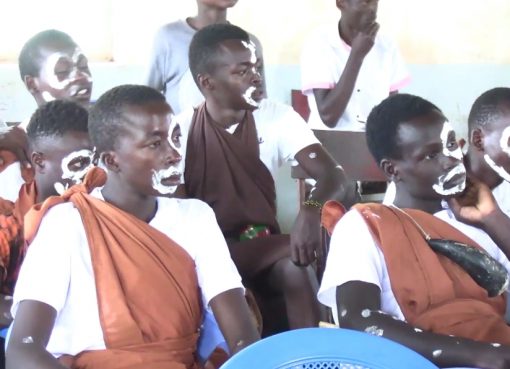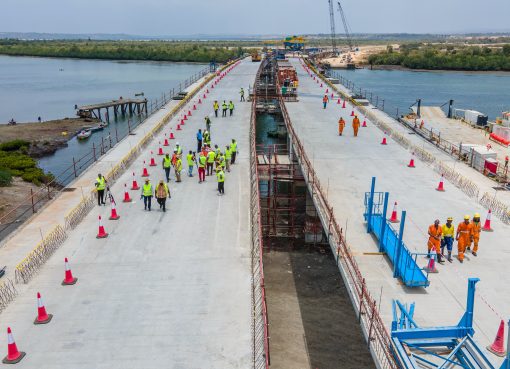The Kenya Wildlife Service (KWS) and the International Tree Foundation (ITF) have scaled up a project to conserve wetlands around Saiwa Swamp National Park which are feeding and breeding grounds for the endangered Sitatunga antelope, Grey Crested Cranes, De Brazza’s monkey, and over 300 species of birds.
The project that has engaged the community-based Kipsaina Crane and Wetland Conservation Group in Trans Nzoia County is providing farmers around the wetlands with alternative environment-friendly activities such as fruit tree planting.
It has also created buffer zones by planting indigenous trees to protect Sitatunga antelope, Grey Crested Cranes, and De Brazza’s monkey breeding areas in the wetlands.
Records from KWS indicate that only 250 of the Sitatunga antelope are remaining in the country: Uasin-Gishu County has 40 at the Kesses scheme; Saiwa National Park in Trans-Nzoia has 60, while Nandi County’s King’wal Swamp has 150. KWS has further stated that in the 1970s, the population of cranes in Kenya stood at 30,000 but a 2019 census showed that number had dropped to 8,000.
According to ITF programs Officer Mr. Wycliffe Matika the wetlands around Saiwa Swamp National Park are threatened due to human activities, deforestation and climate change. He stated that the depth of wetlands is decreasing due to silt brought by rainwater.
Mr. Matika further revealed that the loss of wetlands in many other parts of Kenya was happening at alarming rates fueled partly by increasing demand for land, extreme pollution, flooding of reservoirs, growing population, urbanization, industrialization, and human greed. This, he added, has exposed the country’s wetlands to threats of extinction.
He identified other threats to the survival of wetlands as an illegal abstraction from Feeder Rivers and springs, deforestation, and unplanned grazing patterns.
The programme officer was speaking during a farmer’s training in Trans Nzoia. A series of similar training is ongoing in Nakuru, Kakamega, Meru, Tharaka Nithi, and Kiambu on landscape and ecosystem restoration in a bid to stem further degradation of environmental resources.
The Environmental Management and Coordination Act 1999 defines wetlands as areas permanently or seasonally flooded by water where plants and animals have become seasonally adapted.
“With 80 per cent of Kenya being either arid or semi-arid, we have no option but to save our wetlands from extinction. Besides helping to replenish the groundwater table, wetlands also play a vital role in purifying water. Birds and animals live here, making a significant contribution to human life. Wetlands are rich places in terms of biodiversity. A variety of beneficial herbs are found in the vicinity of wetlands. Guest migratory birds, from foreign countries, come into our wetlands in large numbers every year,” the Programs Officer pointed out.
Mr. Matika indicated that the wetlands rehabilitation project entails the raising of indigenous tree seedlings and distribution for planting on degraded wetlands in western Kenya as well as other parts of the country. Over 30,000 seedlings have been planted over the last six months by members of Kipsaina Crane and Wetland Conservation Group. A major tree nursery is based at Kipsaina.
The project has also supported the establishment of satellite tree nurseries in different parts of western Kenya, initiated projects, and supported innovations that dissuade charcoal burning aimed at minimizing deforestation.
“We support farmers by giving them fruit trees to work as a buffer zone between farmland and the wetlands and help them engage in sustainable agricultural activities,” adds Mr. Matika.
Multipurpose trees and shrubs are being promoted to provide fodder for livestock while at the same time helping to rehabilitate degraded parts of the wetlands.
Matika indicates that growing more indigenous trees in the wetlands besides restoring soil health also has diverse uses as a source of medicinal ingredients.
He quips, “We hope community engagement in conserving the wetlands would be able to contribute to the restoration of this basin. We want to improve on carbon footprint emissions. Wetlands are carbon sinks and therefore contribute in terms of requisitioning carbon.”
Mr. Matika noted that members of Kipsaina Crane and Wetland Conservation Group were also nurturing a generation of young environmental champions by encouraging the youth to channel their energy into tree planting which gives them ‘clean’ sources of income and safeguards their future from climate change effects.
The Warden in Charge of Saiwa Swamp National Park Mr. Phillip Rono revealed that locals around the wetlands harvest bulrush grass (makololwe) preferred by the Sitatunga antelopes and crane birds to use as cattle feed, as thatching material, and during the brick-making.
“It is a challenge that requires collective and concerted efforts to address. Environmentalists, agricultural experts, and the community itself are key stakeholders to jointly tackle the challenge,” he noted.
Mr. Rono states that areas of the swamp to the south of the park bear the greatest brunt as it’s beyond the mandate of the Kenya Wildlife Service (KWS) wardens.
The wetland region, though not forming part of the park, has since been transformed into communal grazing and watering land. A section has been grabbed by individuals owning bordered land.
Sand harvesting is now a common phenomenon as the lack of proper vegetation cover contributes to massive soil erosion in the area and subsequent river siltation.
The Senior Warden observed that the Networking/partnership and advocacy initiative’s main aim is to promote environmental stewardship and influence good governance and management of wetlands resources.
The semi-aquatic Sitatunga, according to Mr. Rono, is threatened by both poachers — who believe its meat has medicinal and mystical powers — and encroachment on its habitat.
“A few years ago, for instance, thousands of acres of King’wal Swamp in Nandi County, were set ablaze during the dry season by farmers who were determined to convert the animals’ swampy habitat into farmland. As a result, the sitatunga’s habitat in the swamp has been reduced almost by half, making it difficult for the antelopes to breed or feed. Besides, the locals have set up large-scale brick-making enterprises on its habitat.”
Mr. Rono noted that the poor farming and livestock husbandry around the habitat and poor waste disposal methods posed great danger to the survival of the vegetation forming the Sitatunga habitat.
“Sitatunga antelopes do not thrive in maize plantations; neither do they survive in eucalyptus tree plantations. They survive in riverine vegetation that we must focus on to conserve at all times,” he stressed.
KWS says that Kenya is the only East African country that boasts of the Sitatunga species.
“Besides conservation efforts, KWS has been aggressively educating local communities in North Rift and Western Kenya on the benefits of preserving the animals.”
“Agriculture, which has been the main income earner in the Rift Valley, is no longer as profitable as it used to be. Venturing into sectors like tourism can create jobs for the numerous jobless youths,” he concluded.
Mr. Maurice Wanjala the country coordinator for Kipsaina Crane and Wetland Conservation Group says that they were working with the community members to reverse the degradation of the wetlands.
“We have lost 80 per cent of the Grey Crested Cranes population. In every wetland in the country, these birds used to be common but this is not the case. Of the current population, we are seeing a big proportion are adults and between two and five per cent are juveniles,” says Mr. Wanjala.
“What this means is that we are having an aging population of cranes. We have more adults than young ones. This is a major risk because in the next few years we might lose the entire population. This is the reason we came up with the initiative in 1990 to reverse this trend.”
Besides being tourist attractions, he says, the birds also help get rid of harmful pests on farms like aphids.
“These birds have an economic value and are beautiful. Although many may perceive them as a nuisance for eating grains such as maize, wheat and other crops, they also help to control the pests on farmlands,” he explained.
These birds have been listed as endangered by the International Union for Conservation of Nature (IUCN).
Experts are also concerned that the bird has changed its adaptability due to interference with its habitat. This has led to conflicts with humans, and some farmers are poisoning the birds.
While noting that our very existence depends on wetlands functioning as sponges to soak in the rain and release it gradually into the rivers and lakes Mr. Wanjala observes that hundreds of thousands of hectares have been drained to provide land for housing, industry, and agriculture.
“Currently, wetlands in Kenya are being degraded at an alarming rate through human activities such as unsustainable mining, dredging, and encroachment. This has led to increased disasters such as floods and droughts and reduced community-coping strategies, leading to damaged properties, injury, and death.”
In Kenya, wetlands occupy about three to four percent — approximately 14,000 square kilometres of the land surface. They fluctuate to six percent in the rainy seasons.
As unique ecosystems, wetlands are highly valued for the services and functions they provide to human beings and other animals and plants.
These include flood control and soil erosion prevention, water purification, and nutrient and toxic retention. They also mitigate climate change and are habitats and centres of key biodiversity and socio-economic importance.
By Jane Ngugi and Charloth Chepkemoi





